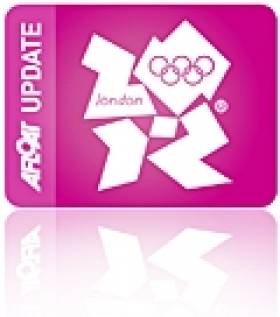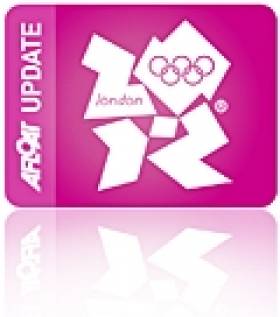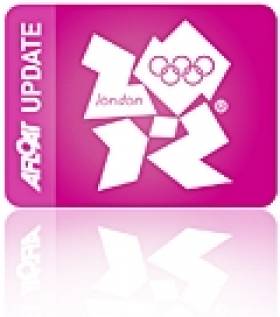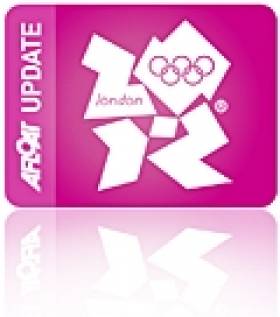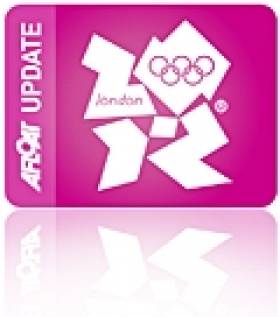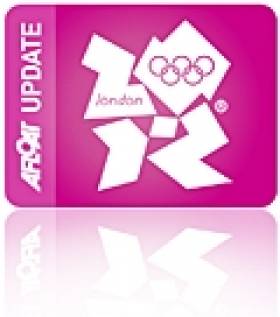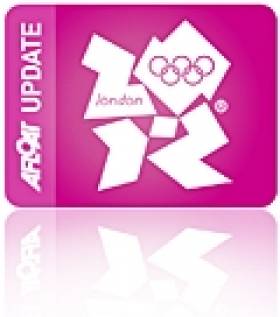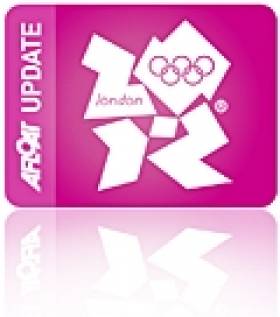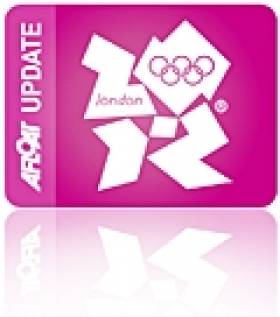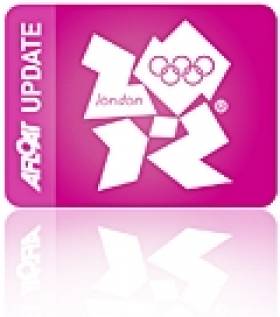Displaying items by tag: Olympic
#sailforgold – Tim Hall believes this year's Skandia Sail for Gold Regatta will be the mostly keenly contested yet with the Olympic Games just under two months away and all five Irish Olympic boats in competition. Ireland is also represented in the race management of the event with Olympic race officer Jack Roy from Dun Laoghaire also on the water in Weymouth this week.
The forecast indicates a moderatly windy week with at least 15 knots of breeze throughout the week.
The event director for the Royal Yachting Association spoke as the 2012 event got underway in Weymouth and Portland - which will host the sailing competition at this year's Olympics.
All of Team GB's sailing squad for the Olympics and Paralympics are competing at Sail for Gold, which is also an ISAF World Cup event. Around 750 sailors are taking part in the regatta with all 10 Olympic and all three Paralympic classes being competed in.
"Skandia Sail for Gold is our largest Olympic multi-class regatta," explained Hall. "We have just over 500 boats and that equates to close to 750 sailors from 55 nations all competing for medals at this event. "It is the last major regatta at this, the Olympic venue, so tensions are certainly high and sailors are looking to stamp their authority in preparation for the Olympics.
"The competition is going to be an exceptionally high (standard), probably the highest we have ever seen.
"The sailors are at the top of their game right now, all prepared and focused on the Olympics.
"It is their last opportunity to train at this venue, so tensions are going to be running very high."
Owens and Flanigan Chalk up a Win in Medemblik
#OLYMPICSAILING – London Olympic 470 pair Ger Owens and Scott Flanigan won the Delta Lloyd Regatta in Medemblik, Holland in the 470 class at the weekend.
Although it is widely recognised the fleet is not at full strength since the World Championships in Barcelona two weeks ago (where Owens and Flanigan qualified for London), the result is nevertheless a boost to the campaign winning four of their nine fleet races.
"This is unexpected. After qualification for the Olympics we weren't busy with winning here, so we're very happy. This is a big surprise for us'', Owens said.
Also competing at the regatta was Annalise Murphy who finished ninth overall and the Irish Paralympic Sailors John Twomey, Anthony Hegarty and Ian Costello in the Sonar class who finished 6th overall.
Show Your Support for #benandrita this Summer
##benandrita – Ben Ainslie has a lot of expectation sitting on him this summer. If he wins a fourth gold in Weymouth he could make history and become the World's most successful Olympic sailor since sailing was introduced at the 1900 Games in Paris.
Every boat Ben has ever owned has been called Rita, and his current Rita is very special. Having sailed her since 2003 she has won two gold medals – no easy task for an old girl! To do their bit to support Ben in the massive challenge ahead, the British Finn Association and J.P. Morgan Asset Management are asking you to show your support for Ben and Rita by tweeting a message of support with #benandrita.
Bens spare 'Rita' is currently on tour and you can see her on display at the National Maritime Museum, Cornwall 2nd – 20th May. It's an interactive display on which you can use iPads to tweet your support for #benandrita.
The display then moves to London. Ben and Rita will be at Canary Wharf station on Monday 21st May and Exchange Square, Liverpool Street station on 22nd May.
You can meet Ben and Rita at the following times:
Monday 21 May – Canary Wharf Station, 1200 – 1400 and 1700 – 1830
Tuesday 22 May – Exchange Square, Liverpool Street, 1200 – 1400 and 1700 –
1830
#benandrita Port and Starboard socks
Exclusive #benandrita Port (left) and Starboard (right) socks have been created to encourage people to show their support for Ben and Rita. Some of the British Finn Association members have sported a pair of the red and green socks whilst competing at the Finn World Championships in Falmouth.
Andy Dennison Chairman of the British Finn Association is keen to get the country behind Ben and Rita. "Ben is a great ambassador for sport, sailing and in particular the Finn Class – we're keen to get the nation behind him and his boat Rita in this key period. The socks are a bit of fun which we hope will catch on and get people out buying red and green socks this summer."
How you can show your support:
Twitter: You can show your support by tweeting a message of support to Ben @ainslieben followed by #benandrita
Facebook: Or post a photo or message on Ben's Facebook page www.facebook.com/benainslie1977
There are 100 pairs of socks to give away in the coming weeks, follow www.facebook.com/benainslie1977 for you chance to grab a pair
Scott Flanigan, from Malahide Yacht Club has recently qualified for the Olympics in the 470 class with Ger Owens. Ger is a double Olympian has represented Ireland in the 470 class in Athens and Beijing where he had two exciting race wins. Ger was Scott's coach for several years prior to the pair teaming up to campaign for London 2012 last summer, and Scott watched Ger racing in Beijing when he was fifteen. Scott who is now nineteen returned home this weekend for a couple of days rest, before resuming their Olympic campaign in Holland, and visited Malahide Yacht Club. He chatted to the Optimist sailors who were training with their coach David and was impressed with the new facility which opened earlier this year. He spoke encouragingly to the children and gave them some advice.
Colin O'Sullivan, one of the junior sailors interviewed Scott.
How did you get to be so good at sailing?
I started sailing an Optimist, then progressed to a Laser and then a 420, but I actually sailed anything that I got a chance to. I tried Catamarans, Mermaids, Yachts, anything that I could. You learn from every bit of sailing that you do, and learn from other sailors. Fitness and diet are also very important and I have been really lucky in having a great personal trainer, Colin Gaffney, from a young age.
Was it fun?
Yes it was, and I thoroughly enjoyed all the travelling I got to do in Ireland and all over the world. I have made great friends through sailing. I have been both a helm and a crew and have learnt a lot from both experiences.
How did you choose what boat to move into after your Optimist?
I won the Munster Championship in my last year, and that was my last Optimist event. I had already been sailing a Laser a bit, and I liked it. I was good in light winds and did pretty well. Then I moved to the 420 which was great, it was a new experience being part of a team, and I really enjoyed the technical side. Having sailed the 420 I think I would be so much better as an Optimist sailor!
What is your routine like?
When we are away training we sail most days. We start at 7am, head to the gym for a session and head out on the water for some training in the morning. We break for lunch for an hour, then back out again for the afternoon. We have spent most of the year in Palma as we are assured of good conditions and have training partners based there.
Do you have coaching every day?
Unfortunately due to financial constraints, we have not had a full time coach but Ross Killian attends most of the events with us as the support is essential when competing.
What other advice do you have?
My advice would be to keep a journal, it's really important. I have notebooks full of training information and things that I have noticed myself. Every sailor should keep a record of what they've learnt and what they've done. You also need goals, every time you go sailing, every event you compete in, try to have a goal. Sailing is not just about winning an event, it is also about improving. You might decide that you are going to improve your starts at a particular event, and that will be a focus while you're competing. Reading is important too, I have quite a library of sailing books I've picked them up all over the place.
What is your favourite place to sail?
It is hard to pick one venue but when I am at home I love to sail in Howth and Kinsale, and in Europe, Lake Garda and La Rochelle.
What were your best sailing moments?
Sailing in the Youth Worlds with Cian O'Regan in Istanbul, and representing Belvedere College with great success in the school sailing events, and of course qualifying for the Olympics.
What would you tell someone my age?
Sail everything you can. I have sailed Optimists, Fevas, 420s, 470s, Catamarans, and all classes of Yachts. I sailed the Topaz Westerns here in Malahide. Looks can be deceiving in boats but you will always learn something new by being adventurous.
Scott is heading off to Holland to continue his Olympic training programme with Ger Owens. We will be watching them and wish them luck.
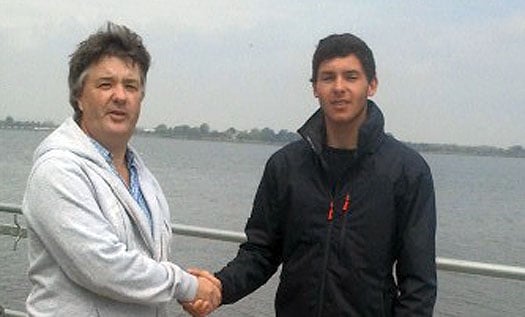
Scott (right) being congratulated on his achievement by MYC commodore Bob Sugrue
Annalise Ends Radial Worlds in 25th Place
#LASER RADIAL – London Olympic debutante Annalise Murphy (22) has finished the week at the Laser Radial World Championships in Germany with a 33rd and a 55th to dropping nine places on the final day to leave her 25th overall in the 133-boat fleet.
After a collision in the opening stages of the regatta it was a tough week for Annalise who also showed her world beating potential taking two wins and two seconds when the breeze was up on the Woehlenberger wiek . Last night Team manager James O'Callaghan said Annaslise has 'plenty of work to do' between now and the Olympics.
Racing was postponed at Boltenhagen for three hours as there was barely any wind but later a sea breeze came in and there were six to eight knots for the first race and ten to twelve knots for the second.
Overall results available for download below as a pdf document.
Afloat's Irish Olympic sailing team news
#OLYMPIC SAILNG – After a busy month of six world Olympic sailing championships Ireland will send a five boat team to the sailing Olympics this July after two more boats were added to the team in the last ten days.
Beyond the qualification celebrations though the heat is on to deliver 'six medal race finishes plus two medals' in pre-Olympic events as a sign that the team is on track to deliver Olympic success in just over eight weeks time. That was the results tab calculation by team manager James O'Callaghan a month ago when he declared the Irish sailing team vision was to 'stand on the podium' in Weymouth in August.
The proclaimation followed the release of ISAF's standings that put both of Ireland's medal contenders in the Laser Radial and Star classes in the top five of the world rankings in January.
So far Peter O'Leary and David Burrows look on target in their keelboat class finishing fourth in the Star Worlds in France this month, one of Ireland's best ever results at an Olympic class world championships and secured when competition is at its hottest in an Olympic year. It follows a sixth in Hyeres Olympic week (even with a broken forestay) and a silver medal (for the third time) at the Star class Bacardi Cup in Miami in March.
Last week Ger Owens and Scott Flanigan finished with a fourth at the 470 world championships in Barcelona and moved up to 24th overall, a result that qualified them for London, Owens' third Olympic regatta and Flanigan's first.
Also through this month to London by virtue of a Gold fleet finish at the Laser worlds in Boltehnagen, Germany is Bangor Laser Sailor James Espey. He is the second Belfast Lough crew on the team joining Ryan Seaton and Matt McGovern who race the 49er dinghy.
And at the same venue Annalise Murphy, finished 25th overall yesterday at the Laser Radial Worlds after an event where an inconsistent score sheet shows how the Dun Laoghaire sailor won two races in her 133-boat fleet but also discarded a 64th at the shifty venue.
Meanwhile Peter O'Leary and David Burrows who were narrowly denied a bronze medal at the Star Worlds a week ago have posted an update on the team website describing themselves as 'happy enough' with fourth overall and how the high quality event gave them the chance to test new gear. 'Some areas we were happy with and others we need to work on', they conclude.
Whatever the outcome in August for the Star keelboat it is the end of the Olympic road.
Annalise 16th at Laser Radial Worlds in Germany
#LASER RADIAL WORLDS – Annalise Murphy's 64th and 33rd scored yesterday in the penultimate day of racing at the Laser Radial World Championships in Germany put her 16th overall with overall scores tighenting significantly at the top of the table.
This season's most consistent sailor, with three World Cup wins under her belt Lijia Xu (CHN) had her worst day of this Boltenhagen regatta with light winds saddling her with a 14th and 12th, these are now her two discards.
However Xu is still ahead of Gintare Scheidt (LTU) in the overall results due to her 12–point lead with which she went into today's races.
The final rounds will be sailed today and there is no medal race in this world championship format.
Yesterday's first start at the Audi Laser World Championship 2012 was postponed for three hours as there was barely any wind. Around 1pm a sea breeze came in and there were six to eight knots for the first race and ten to twelve knots for the second. A small current on the Wohlenberger Wiek kept the sailors in line and there was neither a general recall nor a single early starter during any of the starts.
Although for Lijia Xu (CHN) the racing did not go as smoothly as on previous days she is still ahead of Gintare Scheidt (LTU) in the overall results due to her 12 point lead with which she went into today's races. Scheidt convinced in the first race where she was second but had to discard the sixteenth place from the second race as her worst result in the final series so far. With the second discard after ten races Alison Young (GBR) only adds one point to her overall score and moves back up into third place.
Sari Multala (FIN) slips to fourth place but with only eleven points separating her and Lijia Xu in first place there is still the possibility for some major changes in the overall rankings. Defending World Champion Marit Bouwmeester (NED) is keeping steady in fifth place overall with two ninth places. 18-year-old newcomer Erika Reineke (USA) scored spectacular results in gold fleet today, achieving a third and a first place ahead of fellow countrywoman Paige Railey who finished 20th and ninth.
Reineke is still ahead in the U21 rankings as well, having established a 69 point lead on Brenda Bowskill (CAN) in second place. Michelle Broekhuizen (NED) is in third place.
#LASER RADIAL – Discarding her first race result of 65 keeps Ireland's Annalise Murphy in 15th overall at the Laser Radial worlds in Boltenhagen Germany tonight but a gap of 13 points exists to tenth overall so a place in Sunday's coveted medal race depends on achieving the same results as shed did on Tuesday and Wednesday.
Results available for download as a pdf below.
As the temperatures have been creeping up slowly the wind has calmed down slightly in Boltenhagen, where the first races of the women's Radial final series of the Audi Laser World Championship 2012 are taking place. The famously shifty winds between eight and sixteen knots made for tactically demanding conditions on the water today. "Speed is not the top priority in these conditions", says Principal Race Director Klaus Lahme, "tactically it is more important to catch the right wind shifts."
"I think being consistent is the most important thing for an all-round sailor", adds Lija Xu (CHN) after winning the first gold fleet race and coming in second later in the afternoon. She swops places at the top of the leader board with Sari Multala (FIN) who had an off day with a tenth and a 25th place, her worst results of the entire series so far. Gintare Scheidt from Lithuania pushes from fifth into third place.
Marit Bouwmeester (NED) also improves, she is up from seventh to fifth place in the overall ranking even though the day did not go particularly smoothly for her. She was fifth in the first race and because of her consistent results in the first seven races she was able to discard the 22nd place from today's second race. Sara Winther (NZL) seemed overly eager at the starting line and received two of the 21 black flag disqualifications awarded today. She drops from 13th to 32nd place overall. Paige Railey (USA) continues to deliver steady results and currently places ninth overall. In the gold fleet's second race Anna Weinzieher from Poland managed a fairly unexpected win ahead of Lija Xu and Sophie de Turckheim (FRA).
In the U21 results it is looking good for Erika Reineke from the USA who is able to maintain her lead. Michelle Broekhuizen (NED) claims the second place while Marie Bolou from France drops to third.
#LASER RADIAL WORLDS – Another stunning performance by Annalise Murphy at the 133-boat Women's Laser Radial fleet in Boltenhagen, Germany today moves the Dun Laoghaire sailor up to 15th overall and within striking distance of the top ten overall as the Radials finished the last races of their qualifying series today before being divided into the gold and silver fleets for the finals. The choppy waves out on the Wohlenberger Wiek proved challenging and again there were several capsizes.
In the strong winds London Olympic debutante Annalise is showing her strength and repeats her scores from yesterday with a first and second place. Improving twelve places she is now 15th overall due to a rather disastrous first day of racing where she was 65th and 33rd. Similarly the conditions seem to suit Paige Railey (USA) who is only two places and one point behind Murphy with much more stable Top 10 results over the last two days.
The two Finnish competitors seemed to feel right at home and both scored a first and second in today's races. This pushes Sari Multala from fourth to first place overall, three points ahead of Lija Xu (CHN) who is steady in second place. Alison Young from Great Britain drops to third place as the results of a ninth and fourth place in the yellow fleet.
With the exception of the very first race of the qualifying series Marit Bouwmeester (NED), currently seventh overall, is achieving consistent Top 10 results and will be trying to close the twelve point gap between her and Multala in first place during tomorrow's gold fleet races. Josefin Olsson (SWE) who had been working her way up in the results capsized on the last down wind of the second race, losing two points. Righting her boat fast enough meant she still finished eighth in the blue fleet.
In the U21 ranking another American is pushing ahead. Erika Reineke overtook Marie Bolou (FRA) who had been leading throughout the first two days. In third place is Michelle Broekhuizen (NED), who will be racing in gold fleet tomorrow along with the current Top 10 of the U21 competitors.
Results for download in pdf format below.
#LASER RADIAL – After a disatrous opener yesterday London Olympic prospect Annalise Murphy bounced back to the front of the 133-boat Women's Laser Radial fleet in Boltenhagen, Germany today finishing first and second in her two races moving her up 70 places from 103rd to lie 27th overall.
With 20 knots of wind from 270 degrees on the race course it was the perfect opportnuity for the 6'foot 1" Dun Laoghaire sailor to show her world class heavy air form.
Overall Britian's Alison Young leads the fleet. Results after four races are downloadable below in pdf format.
Racing continues until Saturday with the top 10 sailors progressing to the medal race on Sunday.
Tactically challenging conditions with mildly oscillating winds from 15 to 20 knots today's races lead to interesting changes in the results at the top of the leader board. In uncharacteristically rough waters for Boltenhagen there were several capsizes during the races and in the strong winds some starters were a little too eager, receiving a total of seven black flags.
Young (GBR) was able to discard her 39 points from the very fist race of the series and moves up from 31st to first place in the overall results with a second place and a win. Only four points behind is Lija Xu from China who was fifth in the first race and won the yellow fleet's second race. In third place with eight points like Lija Xu is Cecilia Carranza Saroli (ARG) who came second in the first race but had to discard her 14th place from the second race.
Defending World Champion Marit Bouwmeester (NED) is delivering a steady performance in fifth place, only one point behind the World Champion from 2009 and 2010, Sari Multala from Finland who achieved the same scores as yesterday with a first and eighth place. Even though American Olympic hope Paige Railey placed seventh and fifth today her results from the first day prevent her from moving up significantly in the overall results. She improves from 30th place to 23rd.
France's Marie Bolou is still leading in the U21 results, followed by Erika Reineke (USA) and Michelle Broekhuizen (NED).


























